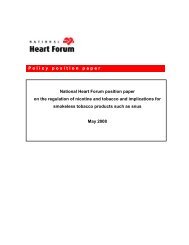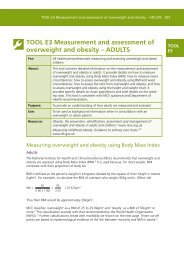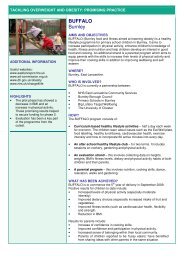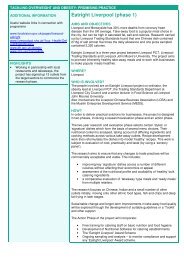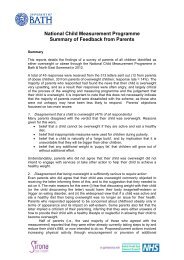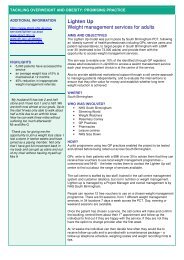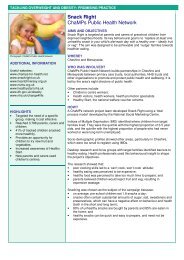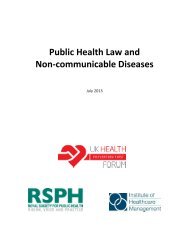The Challenge of Non-Communicable Diseases and Road Traffic ...
The Challenge of Non-Communicable Diseases and Road Traffic ...
The Challenge of Non-Communicable Diseases and Road Traffic ...
Create successful ePaper yourself
Turn your PDF publications into a flip-book with our unique Google optimized e-Paper software.
70 <strong>The</strong> <strong>Challenge</strong> <strong>of</strong> <strong>Non</strong>-communicable <strong>Diseases</strong> <strong>and</strong> <strong>Road</strong> <strong>Traffic</strong> Injuries in Sub-Saharan Africa<br />
BOX 14: Healthier Workplaces = Healthy Pr<strong>of</strong>its<br />
<strong>The</strong> current debate in many countries on how to change a health system that is geared to treat illnesses to one that focuses<br />
on preventing people from getting sick is highly relevant for the question in Africa on how companies can improve<br />
employee health. After all, employees spend most <strong>of</strong> their waking hours at the workplace.<br />
<strong>The</strong>re is a robust body <strong>of</strong> evidence showing that investment in workplace wellness programs is not only good for employees<br />
but also for the bottom line <strong>of</strong> companies. <strong>The</strong>se programs, which are organized <strong>and</strong> sponsored by the employer,<br />
help employees, <strong>and</strong> in some cases, their families, adopt <strong>and</strong> sustain behaviors that reduce health risks associated with<br />
chronic diseases <strong>and</strong> injuries. Both employees <strong>and</strong> employers value these programs because they help reduce health risks,<br />
absenteeism, <strong>and</strong> employee turnover.<br />
<strong>The</strong> entry point for participation in these programs is employee health risk assessments, coupled with clinical screening<br />
for risk factors (such as, blood pressure, cholesterol, <strong>and</strong> body mass index) that provide the baseline for subsequent interventions.<br />
Other methods include self-help education materials, individual counseling with health care pr<strong>of</strong>essionals, <strong>and</strong><br />
on-site group activities led by trained personnel. Besides obesity <strong>and</strong> smoking cessation, programs commonly focus on<br />
stress management, nutrition, alcohol abuse, <strong>and</strong> blood pressure, <strong>and</strong> on preventive care such as the administration <strong>of</strong><br />
the flu vaccine. Companies have begun giving incentives to motivate healthy behavior, such as bonuses for completing<br />
health risk assessments, reimbursements for the cost <strong>of</strong> fitness-center memberships, or lower health insurance premiums<br />
if employees adopt healthier behaviors (for example, quit smoking).<br />
As new strides in global health continue to be made, the workplace should be seen as another promising “entry point” to<br />
tackle not only unhealthy behavior among individuals but also to reduce community health risks (for example, through<br />
the adoption <strong>of</strong> programs to better train truck drivers <strong>and</strong> conduct regular vehicle inspections to prevent road traffic<br />
deaths).<br />
<strong>The</strong> essential pillars <strong>of</strong> these programs are:<br />
• Engaged leadership: Johnson & Johnson helps employees living with HIV/AIDS access ART. Additionally, all <strong>of</strong> its facilities<br />
are smoke-free.<br />
• Strategic alignment with the company’s identity <strong>and</strong> aspirations: To promote a culture <strong>of</strong> health in a company<br />
where 60-70 percent <strong>of</strong> jobs are safety-sensitive, Chevron has made fitness-for-duty a central concern on oil platforms<br />
<strong>and</strong> rigs, in refineries, <strong>and</strong> during the transport <strong>of</strong> fuel. Its wellness program includes a comprehensive cardiovascular<br />
health component, walking activities, fitness centers, stress-injury prevention, <strong>and</strong> work/life services.<br />
• Design that is broad in scope <strong>and</strong> high in relevance <strong>and</strong> quality: To be relevant to the needs <strong>of</strong> their employees,<br />
companies have adopted programs that are not just about physical fitness but also focus on mental health issues such<br />
as depression <strong>and</strong> stress, which are major sources <strong>of</strong> lost productivity.<br />
• Broad accessibility: SAS, a s<strong>of</strong>tware firm, makes low- or no-cost services a priority. This is complemented by convenient<br />
arrangements that ensure high employee participation; for example, recreation facilities that are open before <strong>and</strong> after<br />
work <strong>and</strong> on weekends.<br />
• Internal <strong>and</strong> external partnerships: Companies <strong>of</strong>fer services, such as biometric health screenings, at the worksite.<br />
<strong>The</strong>se, in turn, are used to devise “individualized” programs with a local sport club <strong>and</strong> medical practice for at-risk employees.<br />
• Effective communications: To help overcome employee apathy or sensitivity about personal health issues, some companies<br />
are sharing information about wellness in regular corporate e-mails, health-related messages on intranet portals,<br />
<strong>and</strong> wellness “clues” in the workplace, such as the availability <strong>of</strong> bicycle racks in parking garages with showers nearby to<br />
make cycling to work appealing.<br />
What are the returns on this investment? In the case <strong>of</strong> Johnson & Johnson, since 1995 the percentage <strong>of</strong> employees who<br />
smoked dropped by more than two-thirds, <strong>and</strong> the number who had high blood pressure or were physically inactive declined<br />
by more than half. <strong>The</strong> companies reaped financial rewards as well: thanks to wellness programs in the workplace,<br />
medical costs for U.S. firms fell by about US$3.27 <strong>and</strong> illness-related absenteeism costs dropped by about US$2.73 for<br />
every dollar spent on such programs.<br />
Governments can play an important role in helping implement <strong>and</strong> exp<strong>and</strong> employer wellness programs, not only to<br />
improve the health <strong>of</strong> the population, but also to control health care spending. <strong>The</strong> 2009 Affordable Care Act, adopted by<br />
the U.S. Government to exp<strong>and</strong> health insurance coverage, is a good example, as it exp<strong>and</strong>s employers’ ability to reward<br />
employees who meet health status goals by participating in wellness programs <strong>and</strong> to require employees who don’t meet<br />
these goals to pay more for their employer-sponsored health coverage.<br />
Source: [489-492]



